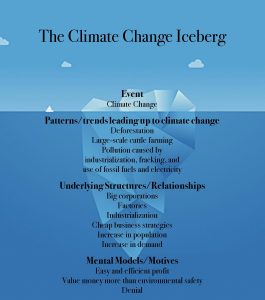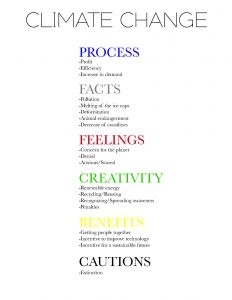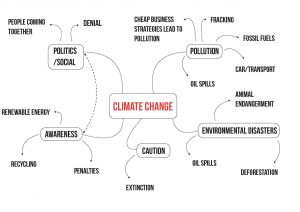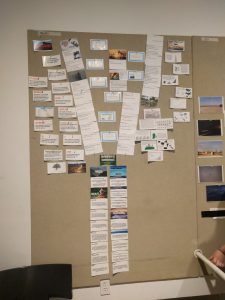Initial issues maps:
For my Bridge Assignment #2, The Story of Research, I was assigned into a group of four which included Emil Waldron, Lionel Miele-Herndon, Mariya Yokoi, and myself. The outline of the assignment was for us to build upon our association and assumption diagrams, and gather information about our shared issue by accessing secondary data and engaging in primary research methods. Our goal of the research process would be to understand the systems behind our chosen issue in greater detail than before.
Our shared interests lead us to research the topic of Climate Change. We assigned each other sub-topics that suited our personal interests, for example, Mariya focused on Fossil Fuels, Lionel focused on Fracking and Pollution, Emil focused on Climate Change Solutions, and I focused on Deforestation & Environmental Consequences.
Prior to the task I had some good knowledge about how deforestation contributes to climate change and the environmental consequences of climate change, therefore I found it much easier to interpret the information I was researching.
Deforestation is a serious threat to the Earth’s environment and atmosphere, as it is a major source of the emissions that cause climate change. To put things in perspective, if deforestation were its own country, it would be the world’s largest emitter, ahead of the United States and joint first with China. Our atmosphere suffers from deforestation because trees and soil have stored an enormous quantity of “terrestrial carbon”, which has accumulated over many years and is rapidly being released into the atmosphere.
Due to such rapid increase in deforestation, 10.8 billion tons of carbon dioxide has been released into the atmosphere annually from tropical deforestation, 2000—2007, and 92,000 square kilometres of tropical forests are lost every year, which is approximately the size of Maine or Portugal.
I found a lot of staggering statistics about deforestation, and theres no doubt that it is one of the biggest contributors to climate change, however, there was one fact that stood out to me the most. “Avoiding deforestation is better for the climate than reforestation”. The solution sounds really straight forward and could/should be enforced as soon as possible without hesitation, however, big companies who are using tropical forests to feed their factories and especially their income, are too greedy to find an alternative. The carbon that has been released into the atmosphere from deforestation will require decades to rebuild, meaning that planting trees alone is not enough. If we allow damaged forests to regrow, we will thereby capture almost half of human caused emissions from other sources.
When choosing to research environmental consequences from climate change, I knew I was going to come across many sources and consequences, therefor I had to narrow my research down into four categories; Forests, Water, Wildlife, and Polar Regions. My research made it evident that climate change is the number one problem the world has to face at the moment. Forests will experience various impacts, first of all, the sub-arctic tree lines will slowly retreat north due to temperature rise, and tropical forests will experience changes in their biodiversity, to an extent where there could be high levels of extinctions. Water; climate change combined with excessive pressures on water such as dredging, damming, pollution ,etc. makes impacts on fresh water supplies worse, with the extremes of flooding and drought becoming more common, and coral reefs will diminish, for example, by 2050 only 5% of Australia’s Great Barrier Reef will remain.
The greatest concern about wildlife is extinction, the decline of a specific species, for example, tiger numbers have declined to as few as 3,200 due to poaching and habitat loss, and climate change is expected to cause sea level rise and further risk of wild fires in already endangered habitats where tigers live.
Polar Regions; in the Arctic air temperatures have increased by 5ºC over the last 100 years, which as a result causes loss of habitat for polar bears and seals, affects local population, and will have astonishing affects on the northern hemisphere, the Antarctic ice sheet is the largest single mass of ice on Earth and has a vital role in the worlds climate, therefor, if it begins to melt, not only will the climate change dramatically but also sea levels will rise significantly.
I was very thrilled to have the opportunity to find first hand experience about the subject and learn more through people who have a great passion for the problem. As a group we set out to find our own organisations and noticed that many protests, marches, and events were scheduled to begin in April, which was a problem for us as we had to finish our project mid-March. I decided to dig deeper and found a presentation by vice president Al Gore, “An Evening with Vice President Al Gore”. We attended the presentation as a group and it was extremely helpful and inspiring. Al Gore answered key questions about whether we can ensure a sustainable future and discuss solutions that could benefit our planet and economy. The presentation made us feel very optimistic about climate change and that there is hope, but only if people unite and work towards solving the problem immediately. Before we attended the presentation, we decided to email a couple of organisations, one of them being the Citizens Climate Change Lobby, who got back to us almost immediately. Nicole Crescimanno, who is the co-leader of Citizens Climate Change Lobby, agreed to have an interview with us, which helped us understand Nicole’s and her organisations role in solving climate change. We were able to record our conversation with Nicole and wrote out the transcript after the interview. We used both the transcripts from the interview with Nicole and the presentation by Al Gore in our final presentation, as we thought it was the most understandable way to show our research to the class. Our notecards were presented in a form of a tree, however, we did not have enough space on the classroom wall to fully depict a tree. We wanted to show all the various categories that were involved in climate change and inform the class about the dangers of this global issue.
Nicole Crescimanno interview transcript: CCLInterview-2ar4z8a
My Formatted Index Cards: environmental consequences + deforestation
Index Card Installation:
Midterm Presentation Script: StudioPerformanceScript-281j2g6



